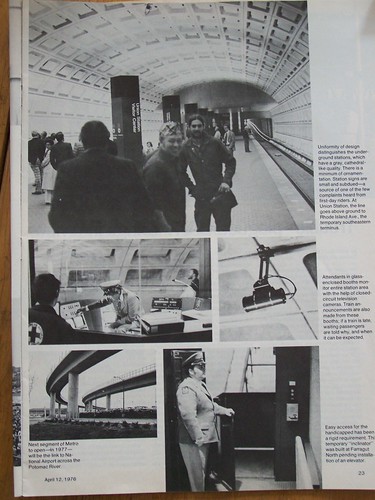WMATA 35th Anniversary and rethinking mobility ... or not
... it will take time before the shopping and employment center redevelops into a mixed-use downtown with a mass of residents who can walk to the stations from home. For now, residents of nearby neighborhoods are accustomed to driving, and there are few firm plans for how people will actually access the stations.
Fairfax County’s challenge lies in identifying the many ways in which McLean, Vienna and Falls Church residents will access the stations on foot, by bicycle and via transit. The goal is “as many options as possible that are alternatives to driving,” said Leonard Wolfenstein, a Fairfax transportation planner.
Some residents pointed out that access should have been integrated into the Metro station planning long ago. “I think this meeting is about five years too late,” said Andrew Gutowski, a real estate developer who is president of his McLean neighborhood homeowners association. “It’s the lack of planning for a continuous and seamless network of alternate transportation,” he said.
Gutowski said his neighborhood has tried unsuccessfully to get the county to build a sidewalk connecting it to downtown McLean, making him dubious about plans for linkage to Tysons.
Concerned residents are right that the planning for this should have started earlier. On the other hand, it's difficult to get people focused on making these kinds of changes in advance of the infrastructure actually opening. (E.g., DC made no accommodations for sidewalk and other improvements before the New York Avenue infill subway station opened. It only occurred to them after the station was opened that something needed to be done.)
The cost of building parking structures to support transit is astronomically expensive, such as the new $26 million parking garage at Glenmont in Montgomery County, which will add spaces for 1,200 cars. See "Glenmont station to increase parking spots for commuters by 67 percent" from the Gazette.
This is important because we don't want people to drive to transit, we want them to be able to use transit efficiently and effectively without having to drive.
-- Fairfax County Transit Development Plan
-- Tysons Corner Bicycle Master Plan
As an example of rethinking, Mike Licht of Notions Capital sends us an article from the London (UK) Daily Telegraph, "EU to ban cars from cities by 2050: Cars will be banned from London and all other cities across Europe under a draconian EU masterplan to cut CO2 emissions by 60 per cent over the next 40 years," about steps the European Community is taking to reduce carbon dioxide emissions, and how that will transform how people get around in cities.
Plus Metro Magazine, a transit trade publication, has a piece about James Madison University in Harrisonburg, Virginia, "Web Extra: James Madison U. to limit on-campus vehicles to boost sustainability."
From the article:
Beginning this August, Harrisonburg, Va.-based James Madison University (JMU) will change how students, faculty, staff and community members navigate campus, with the addition of four gates, reconfigured parking lots around portions of the Bluestone area of campus, some bike lane and crosswalk modifications, and the addition of a bus staging area. ...
"The reason why we did this as a university was to support overall efforts for environmental sustainability. The goal over time being reducing the number of single occupancy vehicles on campus, reducing congestion on campus and reducing a lot of the cut-thru traffic on campus," explained Don Egle, JMU's director of public affairs. "Also, I think what we're going to see is the efficiency of the public transportation system increase, because we are reducing a lot of the vehicles on campus, allowing the buses to move more freely and stay on schedule."
Another primary reason, Egle added was JMU's goal of creating a more pedestrian friendly campus, by making it easier for those who either walk or ride their bicycles.
The gated portion of campus will be closed from 7 a.m. to 7 p.m. Monday through Friday. The gated portion of the campus will be open weeknights after 7 p.m., on weekends, during certain events and during the summer. The new gates on campus, which help control traffic flow, are expected to have little impact on JMU's student body.
"The changes this summer will have a slight impact on some of our faculty and staff," said Egle. "What I mean is they may not be parking right outside their building, but at an adjacent parking lot, for example. But, our students won't see any significant changes in parking, because their lots are located primarily on the perimeter of campus."
Another goal of JMU's program was to cut its overall environmental footprint and increase students' use of the City of Harrisonburg's public transit system.
Today's Richmond Times-Dispatch reports on the success of the Virginia Railway Express (VRE):
"With daily ridership of more than 16,000, the VRE's commuter trains have more than doubled ridership over the past decade as traffic congestion has gotten worse in the Washington area, Dale Zehner told members of Virginians for High Speed Rail at the Science Museum of Virginia. The 'real issue is the demand for service outstrips our supply of seats and parking,' said Zehner, a retired Navy captain who has worked for the commuter railroad since 1995. In Fredericksburg, the VRE's southern terminus, 'We're turning away people because they can't park.'"
Maybe, comparable to the Montgomery County Ride On system, they could consider complementing the heavy rail system with buses designed to get people to stations, and reducing the demand for parking, allowing the commuter railroad to spend more money on rolling stock? By determining critical mass centers of origination for rail trips, bus service could be provided in a relatively low cost fashion.
Labels: car culture and automobility, mobility shed, transit, transportation planning, urban design/placemaking




0 Comments:
Post a Comment
<< Home